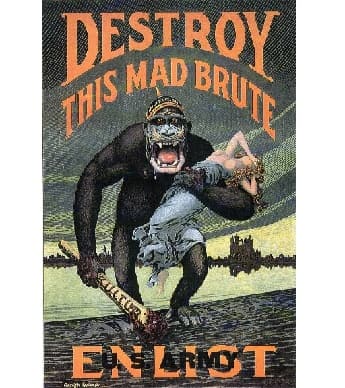Introduction - WW 1 Propaganda
During World War 1 propaganda was used by all the major world powers in an attempt to influence citizens to support the countries war effort including getting people to enlist in the military. This propaganda took many visual and written forms and was spread in many ways including war posters, books, leaflets, and newspaper articles. Propaganda almost always involved a distortion of the truth and often outright lies. Below is a list of facts about World War 1 propaganda. This information is written for both kids and adults and includes what types of propaganda were used, who was responsible for WW1 propaganda, and how effective it was.Click here for a great selection of Amazon.com books about WW1.
List of World War 1 Propaganda Facts
- Propaganda was effectively used by the governments of the world's super powers during World War One to persuade millions of people to enlist in the military and to support the country's war effort.
- Propaganda was used during the Great War (WWI) to create or enhance people's feelings of nationalism.
- The various objectives of WW1 propaganda include getting people to join the army, to conserve food and materials so that more would be available for the war effort, and to get people to support the war financially (often by buying war bonds).
- War posters and other propaganda often appealed to men's emotions by trying to convince them that joining the army would bring them fame, glory, and that they would become heroes.
- Propaganda during this war tried to convince men that serving in the army would be a great adventure. The poor men that believed this would later learn that it was a lie and life for most men in the army was an incredible hardship full of death, disease, and misery.
- Some of the war's propaganda focused on creating feelings of guilt in people who did not join the army or did not contribute to the war effort.
- WW1 propaganda often distorted the truth or outright lied. For example the enemy was often portrayed as a monster in war posters and newspapers were known to drastically understate death tolls.
- The British government was very effective at spreading propaganda. The focus of a lot of the British propaganda was too appealed to people's sense of national honor. One example is a poster of a small girl sitting on her father's lap asking "Daddy, what did you do in the Great War" with the father sitting there with an empty and guilty look on his face.
- Several countries created posters and flyers encouraging women to help the war cause by taking on jobs previously considered men's work, such as working in factories; in order to replace the men that had gone off to war.
- British and American propaganda demonized the Germans. A lot of this propaganda described countless atrocities committed by the German Army. After the war most of these claims were proven to be exaggerations and some were proven to be outright lies. During WW2 this had the unfortunate effect of making people question the reports of the atrocities Nazi Germany was committing, which were of course true.
- World War One was the first war to see propaganda used on a grand scale and this war set the standard for the use of propaganda in future wars. The Germans, including Adolf Hitler, realized the effective use of propaganda by their enemies had been a main factor in their losing WWI. They learned from their mistakes and employed many British and American propaganda techniques prior to and during World War 2.
